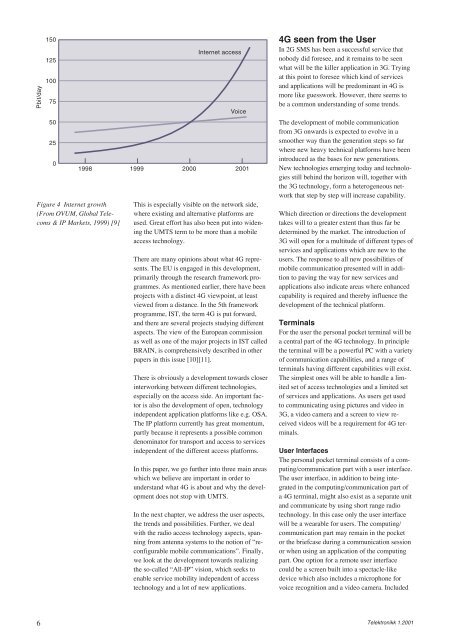Create successful ePaper yourself
Turn your PDF publications into a flip-book with our unique Google optimized e-Paper software.
Pbit/day<br />
6<br />
150<br />
125<br />
100<br />
75<br />
50<br />
25<br />
0<br />
Figure 4 Internet growth<br />
(From OVUM, Global Telecoms<br />
& IP Markets, 1999) [9]<br />
Internet access<br />
Voice<br />
1998 1999 2000 2001<br />
This is especially visible on the network side,<br />
where existing and alternative platforms are<br />
used. Great effort has also been put into widening<br />
the UMTS term to be more than a mobile<br />
access technology.<br />
There are many opinions about what 4G represents.<br />
The EU is engaged in this development,<br />
primarily through the research framework programmes.<br />
As mentioned earlier, there have been<br />
projects with a distinct 4G viewpoint, at least<br />
viewed from a distance. In the 5th framework<br />
programme, IST, the term 4G is put forward,<br />
and there are several projects studying different<br />
aspects. The view of the European commission<br />
as well as one of the major projects in IST called<br />
BRAIN, is comprehensively described in other<br />
papers in this issue [10][11].<br />
There is obviously a development towards closer<br />
interworking between different technologies,<br />
especially on the access side. An important factor<br />
is also the development of open, technology<br />
independent application platforms like e.g. OSA.<br />
The IP platform currently has great momentum,<br />
partly because it represents a possible common<br />
denominator for transport and access to services<br />
independent of the different access platforms.<br />
In this paper, we go further into three main areas<br />
which we believe are important in order to<br />
understand what 4G is about and why the development<br />
does not stop with UMTS.<br />
In the next chapter, we address the user aspects,<br />
the trends and possibilities. Further, we deal<br />
with the radio access technology aspects, spanning<br />
from antenna systems to the notion of “reconfigurable<br />
mobile communications”. Finally,<br />
we look at the development towards realizing<br />
the so-called “All-IP” vision, which seeks to<br />
enable service mobility independent of access<br />
technology and a lot of new applications.<br />
4G seen from the User<br />
In 2G SMS has been a successful service that<br />
nobody did foresee, and it remains to be seen<br />
what will be the killer application in 3G. Trying<br />
at this point to foresee which kind of services<br />
and applications will be predominant in 4G is<br />
more like guesswork. However, there seems to<br />
be a common understanding of some trends.<br />
The development of mobile communication<br />
from 3G onwards is expected to evolve in a<br />
smoother way than the generation steps so far<br />
where new heavy technical platforms have been<br />
introduced as the bases for new generations.<br />
New technologies emerging today and technologies<br />
still behind the horizon will, together with<br />
the 3G technology, form a heterogeneous network<br />
that step by step will increase capability.<br />
Which direction or directions the development<br />
takes will to a greater extent than thus far be<br />
determined by the market. The introduction of<br />
3G will open for a multitude of different types of<br />
services and applications which are new to the<br />
users. The response to all new possibilities of<br />
mobile communication presented will in addition<br />
to paving the way for new services and<br />
applications also indicate areas where enhanced<br />
capability is required and thereby influence the<br />
development of the technical platform.<br />
Terminals<br />
For the user the personal pocket terminal will be<br />
a central part of the 4G technology. In principle<br />
the terminal will be a powerful PC with a variety<br />
of communication capabilities, and a range of<br />
terminals having different capabilities will exist.<br />
The simplest ones will be able to handle a limited<br />
set of access technologies and a limited set<br />
of services and applications. As users get used<br />
to communicating using pictures and video in<br />
3G, a video camera and a screen to view received<br />
videos will be a requirement for 4G terminals.<br />
User Interfaces<br />
The personal pocket terminal consists of a computing/communication<br />
part with a user interface.<br />
The user interface, in addition to being integrated<br />
in the computing/communication part of<br />
a 4G terminal, might also exist as a separate unit<br />
and communicate by using short range radio<br />
technology. In this case only the user interface<br />
will be a wearable for users. The computing/<br />
communication part may remain in the pocket<br />
or the briefcase during a communication session<br />
or when using an application of the computing<br />
part. One option for a remote user interface<br />
could be a screen built into a spectacle-like<br />
device which also includes a microphone for<br />
voice recognition and a video camera. Included<br />
Telektronikk 1.2001

















